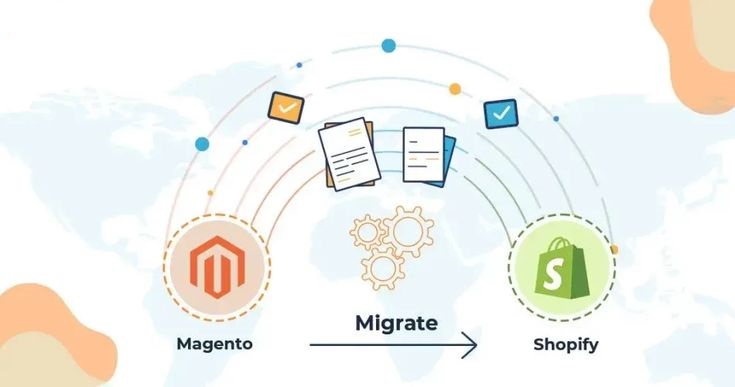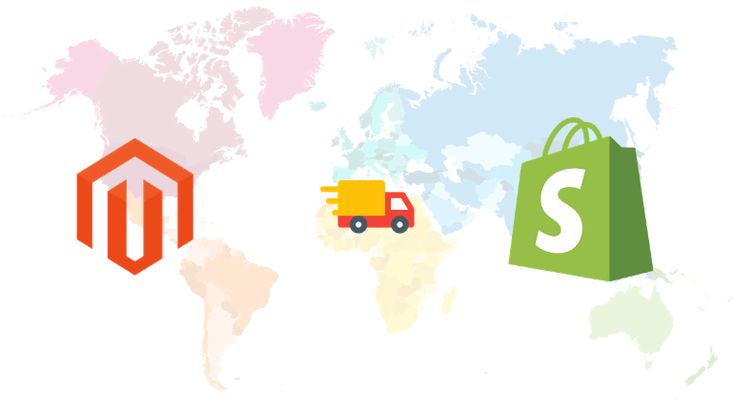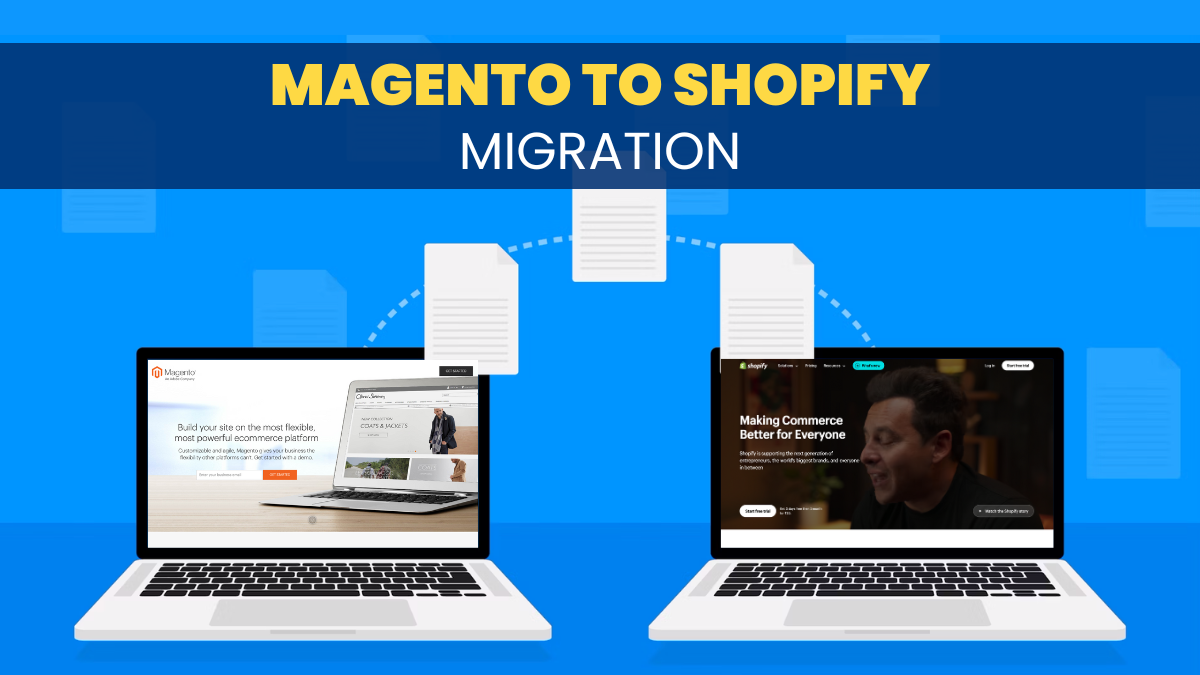Choosing an e-commerce platform from options like Shopify, WooCommerce, BigCommerce, and Magento can be challenging. Each platform offers unique features and benefits, making it essential to assess your specific needs before deciding. Evaluating factors such as ease of use, customization options, and overall scalability is crucial.
The Magento to Shopify migration process has become a preferred choice for many businesses. Shopify’s scalability and comprehensive feature set make it suitable for both small startups and large enterprises. Its user-friendly interface and robust support system further enhance its appeal, making the Magento to Shopify migration even more attractive.
In addition to its core offerings, Shopify Plus provides advanced functionalities for high-growth businesses. Regular updates ensure that Shopify and Shopify Plus align with current e-commerce trends. This commitment to innovation helps maintain a competitive edge over other platforms like Magento, making the Magento to Shopify migration a strategic move for many.
For businesses looking to stay ahead in the e-commerce landscape, Shopify’s consistent improvements and feature-rich environment offer a strong foundation. Its rapid growth and adaptability make it a viable option for new ventures and those considering migration from other platforms. By choosing Shopify, especially through a Magento to Shopify migration, businesses can leverage a reliable and evolving platform to support their online operations.
Overview
Migrating to Shopify from Magento requires careful planning to avoid potential issues. This process involves several critical aspects that need to be addressed thoroughly. It is essential to ensure a smooth transition without disrupting your business operations.

The post comprehensively covers the core basics necessary for a successful migration. These include handling products, maintaining URLs, and managing orders effectively. Each component ensures that your online store functions seamlessly on Shopify.
Additionally, customer data must be transferred accurately to maintain a consistent customer experience. The guide also delves into database management to ensure that all your data is securely and correctly migrated. Managing collections, categories, and tags is also covered to help organize your products efficiently on the new platform.
Our Shopify design and development experts specialize in assisting with Magento to Shopify migration, ensuring a seamless and efficient transition for your online store. services offer additional support for those seeking further assistance. They are designed to help you navigate the complexities of the migration process. For more detailed information, please get in touch.
Reasons to Migrate Your Store to Shopify from Magento
Moving your store to Shopify from Magento presents several benefits. Shopify offers a more intuitive interface, facilitating smoother store management. Additionally, Shopify’s hosted solution enhances reliability and security, lessening the maintenance workload.
Steps to Migrate to Shopify from Magento
The migration process comprises several essential steps. Initially, ensure to back up your Magento store to safeguard all your data. Then, acquire a data import application for Shopify to streamline your store’s information transfer.
Exporting and Importing Data
The subsequent procedure involves exporting data from Magento. This data encompasses products, collections, categories, blogs, pages, customers, previous orders, and discounts. Following the exportation, the data must be imported into Shopify utilizing the previously acquired import application.
Importing Specific Data Elements
When initiating the import process, transfer the products from Magento to Shopify. Subsequently, import collections and categories to preserve your store’s organizational framework. Finally, import blogs and pages to maintain your existing content and SEO advantages.
Customer and Order Data
Customer information and previous orders are essential elements of your store. Transferring customers from Magento to Shopify is crucial for retaining your customer base. Moreover, importing past orders ensures consistency in your sales records.
Final Steps in Data Migration
The concluding phases of data migration encompass importing discounts and establishing Shopify redirects. This safeguards promotional offers and guarantees accurate redirection from old URLs to new Shopify URLs. After data migration, you can proceed with designing your Shopify store.
Key Considerations for Migrating to Shopify from Magento
When migrating, it’s important to carefully assess the variations in platform functionalities and features. Take the time to thoroughly evaluate Shopify’s design and customization options to confirm they align with your specific business requirements. Additionally, it’s essential to plan ahead for potential downtime and focus on facilitating a seamless transition for your customers.
Reasons To Migrate Your Store From Magento To Shopify
Given Shopify’s rapid evolution in recent years, now is an opportune moment to transition from Magento. Shopify consistently enriches its array of apps, add-ons, and features, markedly enhancing the functionality of online stores across various scales. It outpaces competitors like Magento by empowering merchants to deliver a robust user experience.
Furthermore, the platform affords superior control over design aesthetics, enabling businesses to craft visually appealing and highly customizable online storefronts. Additionally, Shopify offers excellent avenues for international expansion, simplifying businesses’ ability to penetrate global markets and expand their clientele.
Additionally, Shopify boasts a swift and highly secure hosting infrastructure, ensuring robust data protection and swift access to information, augmenting security and performance. These aspects collectively render the migration from Magento to Shopify and Shopify Plus a notably fruitful investment in the development and growth of your online enterprise.
According to e-commerce trends on BuiltWith, Shopify is witnessing substantial growth in the number of stores, while Magento is experiencing a decline in merchant usage. Numerous merchants are migrating from Magento to Shopify due to low operational costs. The diminished necessity for patch fixing and generally reduced development expenses also position Shopify as a more financially prudent solution.
Steps To Migrate To Shopify From Magento

To begin migrating from Magento to Shopify, merchants must establish a Shopify account and select an appropriate pricing plan based on their business requirements. The main Shopify pricing plans are:
- Basic Shopify ($29 monthly): Suitable for new e-commerce businesses with occasional in-person sales.
- Shopify ($79 per month): Ideal for growing businesses already selling online or in-store.
- Advanced Shopify ($299 per month): Best for scaling businesses that require advanced reporting features.
Migrating from Magento involves several critical steps but can be accomplished without issues if approached systematically. The process starts with exporting all your data from your Magento store, including products, collections, customers, blogs, users, and pages. This data must then be imported into Shopify. Additionally, you must migrate any associated data, such as tags and metafields, which are integral to your store’s functionality.
It is important to note that you cannot transfer the visual design and layout of your Magento store directly to Shopify due to the inherent differences between the two platforms. As a result, you will need to choose a new Shopify theme that aligns with your brand’s aesthetics or hire an agency to create a custom Shopify theme tailored to your needs.
Given the complexity of this process, particularly for businesses with unique functionalities or extensive inventories, it is advisable to engage a Shopify agency. These professionals can manage the migration process, ensuring all data is accurately transferred and your store functions seamlessly on Shopify. Learn more about available migration services.
While migrating from Magento to Shopify requires careful planning and execution, following these steps ensures a smooth transition. By exporting your Magento data, selecting the right Shopify plan, and possibly engaging expert help, you can successfully migrate your store to Shopify and continue to grow your business.
Secure Your Magento Store With Backup Measures
Merchants migrating from Magento to Shopify must approach the transition with careful planning. Rushing through this process can result in costly mistakes affecting business operations. It is crucial to adopt a methodical approach, ensuring every step is executed precisely to minimize risks and maximize the likelihood of a successful migration.
Before initiating data migration, prioritize creating comprehensive backups of your store’s database and media. This precaution serves as a safety net, providing a fallback option in case of issues during the migration process. By creating backups within the Magento platform, accessed through the Admin panel sidebar, merchants can safeguard their valuable data and minimize the impact of any complications.
Merchants can access the necessary tools to efficiently generate backups by navigating through the Magento Admin panel sidebar. By following ‘System’ > ‘Tools’ > ‘Backups,’ merchants can initiate the backup creation process. This approach ensures that all essential data, including media files and database records, is securely stored ready to be utilized during the migration process.
During the migration, it is essential to focus on minimizing disruption to customers while ensuring comprehensive backup coverage. By prioritizing customer experience, merchants can mitigate the risk of negative impacts on their user base, preserving satisfaction and loyalty. Simultaneously, having a robust backup strategy provides merchants with peace of mind, knowing they have a contingency plan if any issues arise during the migration.
A methodical and cautious approach is essential when migrating from Magento to Shopify. Merchants can confidently navigate the migration process by prioritizing thorough preparation, including creating backups and considering customer impact. By adhering to best practices and focusing on operational efficiency and customer satisfaction, merchants can mitigate risks and optimize the success of their transition to Shopify.
Get The Shopify Data Import App Now
The first step when transitioning from Magento to Shopify is backing up your store. Once this essential task is complete, the focus shifts to the migration process itself. To facilitate this transition, you’ll need to acquire and install a data-importing application tailored to Shopify’s requirements.
While some data, such as product listings, can be directly imported through the Shopify platform, other critical elements like blog posts and historical orders require using Shopify’s API. Fortunately, specialized apps are available to integrate seamlessly with Shopify. These apps, like Matrixify, eliminate the need for extensive development knowledge or the hiring of Shopify-specific developers.
Matrixify offers a comprehensive solution for bulk import and export operations. It supports various data types, including products, collections, customers, discounts, orders, payouts, pages, blog posts, and page redirects. Although the app has a fee structure based on the volume of data imported, many providers offer a trial period to evaluate its efficacy for migration needs.
One of the primary challenges users encounter when employing Matrixify is ensuring that their data is formatted correctly for compatibility with the application. This step is vital for ensuring a smooth integration process. However, this hurdle can be overcome with proper preparation and attention to detail, paving the way for a successful migration from Magento to Shopify.
Throughout this process, it’s essential to maintain a focus on organizational integrity to minimize disruptions to your business operations. By keeping your data organized and readily accessible, you can mitigate the potential impact of the migration on your day-to-day activities. Ultimately, committing to the migration to Shopify represents a strategic decision that can yield significant benefits in terms of scalability, flexibility, and overall performance for your online store.
Magento Data Export And Import: Streamlining Your Processes
To proceed, you need to export your data from Magento to prepare it for import into Shopify. This can be done using either your import app or Shopify’s dashboard. The essential data you will need includes products, category pages, customers, previous order data, blog posts, pages, and page URLs. Magento provides a bulk export feature which simplifies this process.
The method for exporting data varies depending on the version of Magento you are using. This guide outlines the steps for exporting data from Magento 2.
To export data from Magento 2:
- In the “Admin” sidebar, navigate to “System” > “Data Transfer” > “Export”.
- In the “Export Settings” section, set the “Entity Type” to “Products”. This ensures that you are exporting product data.
- Accept the default export file format, which is CSV. This format is widely supported and compatible with Shopify.
- Scroll down to the bottom of the page and click “Continue” in the bottom right corner. This will initiate the export process.
- All exported files are saved in the /var/export folder. If the remote storage module is enabled, the files will be in the /import_export/export folder instead. Depending on your server setup, you may need to access these folders via your hosting provider’s control panel or an FTP client.
Exporting data can be complex, especially if you are unfamiliar with Magento’s backend or data handling procedures. If you are uncomfortable performing these steps, it is advisable to seek assistance from a professional with expertise in Magento and data migration. This will help ensure that your data is accurately and securely transferred to Shopify.
Transferring Data To Your Shopify Store
Understanding the nuances of importing data into Shopify is crucial. Although the platform provides a native feature for importing certain data types directly through its admin page, not all data formats are supported. Third-party solutions like Matrixify or the Shopify API are necessary when direct import isn’t feasible. These alternatives expand the scope of data import, ensuring a comprehensive approach to managing your store’s information.
Accurate data transfer into Shopify is key, regardless of the method used. Whether relying on third-party apps or the Shopify API, ensuring error-free data is vital. Mistakes during import can compromise data integrity and create issues in your Shopify store, disrupting operations. Therefore, attention to detail is essential for maintaining consistent and reliable data.
Shopify simplifies importing certain data sets, such as products and customer information, by offering direct import options within the admin interface. However, alternative methods are required for more complex data structures or unsupported formats. Third-party apps or custom API integrations enable the import of diverse data types, allowing merchants to transition their data seamlessly into Shopify.
Matrixify is a versatile solution for data import tasks, especially when data restructuring is necessary. Its capabilities allow merchants to streamline the import process by rearranging data formats to match Shopify’s requirements. This flexibility speeds up the import process and minimizes errors, enhancing efficiency and accuracy.
For detailed guidance on transitioning data from Magento to Shopify, Matrixify offers a dedicated guide addressing specific challenges and considerations. This resource provides valuable insights and strategies for a smooth migration process. By leveraging available expertise and tools, merchants can confidently navigate data import complexities, ensuring a seamless transition to the Shopify platform.
Importing Products from Magento to Shopify: A Step-by-Step Guide
Thanks to Shopify’s built-in product import feature, importing products is simple. You can start the import process with a click of a button. All you need is a CSV file containing detailed information about your products, including images, weight, color, pricing details, and more.
However, the real challenge is ensuring your CSV file meets Shopify’s specific requirements. Structuring your data correctly is crucial to avoid any issues during the import process. Shopify offers a detailed import and export guide and tutorials to help you navigate this process effectively.
With the right approach, migrating from Magento to Shopify can be seamless. Begin by exporting your products from Magento into a CSV file. Then, organize and manipulate the data to match Shopify’s product import CSV template. This includes arranging details such as titles, descriptions, categories, variants, and SEO information to ensure consistency.
Once you’ve prepared your CSV file according to Shopify’s specifications, you can proceed with the import process. After uploading the file, Shopify will notify you via email once the import is successfully completed. This confirmation ensures that your products are now integrated into Shopify’s database, ready for further customization and management within the platform.
How To Transfer Collections And Categories From Magento To Shopify
The native Shopify dashboard does not support the direct import of collections. However, collections can be added during the product import process, triggering Shopify to automatically generate corresponding collections. This method simplifies the initial setup of collections alongside products.
Depending on your collection requirements, manually setting them up within the Shopify admin might be more efficient. For instance, if products have been imported with relevant tags, Automated Collections can be created. This feature enables the assignment of specific criteria, like tags, to dynamically populate collections.
For example, an Automated Collection can be configured to include all products tagged with “Men’s Shoes.” This ensures collections remain current without continual manual adjustments, facilitating organized and relevant product groupings.
In cases of numerous collections, it is advisable to utilize a third-party app for creation. These apps handle bulk operations more efficiently and provide advanced features, streamlining the process and saving time while ensuring accuracy in managing extensive collections.
How To Transfer Blogs And Pages From Magento To Shopify
Shopify does not provide a native method to import pages and blogs directly into the platform. However, moving your previous content is crucial to prevent significant SEO impacts when migrating to Shopify from Magento. Neglecting this step can lead to losing search engine rankings and traffic, affecting your online store’s performance.
Many third-party apps in Shopify’s app store offer solutions to import blogs and page content into Shopify. These apps facilitate the migration process, ensuring that your content is transferred smoothly and efficiently. Using these tools can save time and reduce the risk of errors during the migration.
Note that Shopify’s native pages and blogging features allow only a title and a single rich text field. To enhance your content, use Shopify’s online store 2.0 template editor. This editor enables the creation of additional content modules, which you must set up after importing the bulk of your content.
By taking these steps, you can ensure a seamless transition to Shopify while maintaining the integrity of your ecommerce SEO and content structure. Proper planning and the use of third-party tools are essential for a successful migration.
How To Transfer Customers From Magento To Shopify
Shopify offers a built-in method for importing customer lists directly into the platform. Their online guide provides detailed instructions for this process. However, note that passwords cannot be imported into Shopify because they are encrypted externally.
Consequently, customers must be invited to reactivate their accounts and set new passwords. Shopify Plus users can use the Bulk Inviter app by Shopify, which can automatically email all customers with a request to set new passwords, greatly simplifying the process.
For users not on Shopify Plus, a third-party provider like Invite Sender is necessary to manage this task. This service can send the required emails to customers, prompting them to set new passwords. If your customer base is small, you can manually send these invitations through the Shopify admin.
By following these steps, you can ensure a smooth transition for your customers as they reactivate their accounts on Shopify. The available tools and services can help streamline this process, whether handled in bulk or individually.
How To Transfer Orders From Magento To Shopify
Shopify’s platform does not provide a direct method for importing previous orders. However, third-party solutions like Matrixify can facilitate the transfer of historical order data. This integration is crucial for businesses transitioning to Shopify while preserving past transaction records.
Importing previous orders into Shopify serves two main purposes. Firstly, it enhances the customer experience by allowing them to access their complete order history. Secondly, it offers convenience to merchants, enabling them to manage and analyze their customers’ purchasing behavior within the Shopify ecosystem.
Understanding the limitations of importing orders into Shopify is important, especially regarding payment-related information. While order history can be migrated, payment details and order statuses cannot be transferred to Shopify Payments. Therefore, merchants cannot process refunds through Shopify for transactions conducted on other platforms, like Magento.
This distinction highlights the need to understand the scope and capabilities of Shopify’s native features and integrations. While it simplifies many aspects of e-commerce management, certain functionalities may require additional tools or manual processes. Being aware of these nuances ensures a more informed and effective use of Shopify as an e-commerce solution.
Also Read: Unlock Your Shopify Store Success: An Ultimate SEO Checklist with Infographic
Importing Discounts From Magento To Shopify: A Step-by-Step Guide
Shopify’s native functionalities don’t include a direct method for importing discounts into the platform. This lack of a built-in feature can challenge users seeking to streamline their discount management processes. However, alternative solutions are available to address this limitation effectively.
One such solution is Matrixify, a third-party application that facilitates importing various data into Shopify. Using Matrixify or similar apps, users can seamlessly bridge the gap between their existing discount data and the Shopify platform. This offers a practical workaround for businesses aiming to import previous orders and associated discounts.
For users considering Matrixify as their preferred solution, it’s crucial to understand the steps involved in the process. Fortunately, Matrixify provides a comprehensive guide detailing importing discounts in bulk to Shopify. This valuable guide offers clear instructions and insights to ensure a smooth and efficient import process.
Compatibility and data integrity must be prioritized when implementing Matrixify or any third-party app for discount importation. Users should verify that the chosen solution aligns with their specific needs and integrates seamlessly with their existing Shopify setup. Additionally, attention to detail during the importation process is crucial to avoid any discrepancies or errors in discount allocation.
While Shopify itself may not offer a native solution for importing discounts, users have access to reliable third-party apps like Matrixify. These tools empower businesses to efficiently manage their discount data and streamline operations within the Shopify platform. By following the guidance provided by Matrixify and exercising diligence in implementation, users can effectively import discounts in bulk, enhancing their overall Shopify experience.
Setting Up Page URL Redirects From Magento To Shopify: A Step-by-Step Guide
Managing URL page redirects is crucial to safeguard your SEO performance when transitioning between ecommerce platforms, such as moving from Magento to Shopify. Each platform typically has its own unique URL structure, so the URLs customers use to access your products may change significantly. Failing to address this transition effectively can result in customers encountering 404 error pages, potentially losing sales and harming your SEO rankings.
To mitigate the impact of URL changes, it’s essential to establish automatic URL redirects, known as 301 redirects. These redirects guide users from the old URLs to the corresponding new ones, minimizing disruptions to their browsing experience. While platforms like Shopify don’t offer direct manual URL import options, third-party tools like Matrixify can facilitate the transition process.
Before setting up redirects, compile a comprehensive list of all your site’s URLs. This step ensures that no page is left unredirected, preventing lost traffic and potential sales. Utilizing website crawling tools like Screaming Frog can expedite this process by automatically generating a detailed list of URLs for redirection purposes.
Once you have a complete list of URLs, update them in bulk with the new redirect destinations. This task can be time-consuming, especially for larger ecommerce stores with extensive product catalogs. However, leveraging spreadsheet software can streamline the process, allowing you to map old URLs to their corresponding new ones efficiently.
Furthermore, adhere to best practices when setting up redirects to avoid confusion for both search engine crawlers and customers. Using the canonical version of the URL ensures consistency and clarity in indexing, preventing duplicate content issues and preserving SEO integrity. For instance, Shopify supports multiple URL structures, so ensuring redirects lead to the main URL variant is essential for a seamless transition.
Designing Your Shopify Store
Following the successful migration of your store from Magento to Shopify and thorough validation of all data fields, the next pivotal phase is dedicated to crafting the design of your new Shopify store. Shopify offers a distinct advantage over Magento in terms of aesthetic control, presenting a diverse selection of themes that can be seamlessly customized to reflect your brand’s identity. It’s imperative to invest time and effort into designing a store layout that not only aligns with your brand’s ethos but also delivers a unique and compelling customer experience, setting your store apart from competitors and fostering customer loyalty.
When considering the design of your Shopify store post-migration, it’s worth noting that Shopify’s platform empowers businesses with the flexibility to tailor their online presence to suit their specific needs and preferences. Whether it’s selecting a pre-designed theme or commissioning a custom design, the aim is to create a visually appealing and user-friendly interface that resonates with your target audience.
While Magento’s aesthetics cannot be directly imported due to differences in code languages, this transition presents an opportunity to refresh your store’s appearance and optimize its performance on Shopify’s platform.
Our team stands ready to provide expert guidance and support for businesses seeking professional assistance in crafting a bespoke design for their Shopify store. Our Shopify developers possess the expertise and creativity to translate your brand vision into a visually stunning and functionally robust online storefront. By collaborating with our team, you can ensure that your Shopify store not only meets but exceeds your expectations in terms of design aesthetics and user experience.
With the migration from Magento to Shopify now completed, the final step entails launching your new store and monitoring its performance closely. As Shopify continues to evolve and introduce new features, staying informed about these updates and exploring opportunities to enhance your store’s functionality and appeal is essential. By staying proactive and responsive to emerging trends and customer preferences, you can position your Shopify store for sustained success and growth in the dynamic e-commerce landscape.
Also Read: 15 Shopify Speed Optimization Apps for Your Online Store
Transitioning From Magento To Shopify: Factors To Consider
Several factors must be considered when migrating from Magento to Shopify. Merchants need to determine the scope of the migration, identifying essential data such as customer information, inventory, and order history. Additionally, it is necessary to assess whether any Magento extensions or plugins need replacement on Shopify.
Next, selecting an appropriate migration method is crucial. Options include using a data migration tool, hiring a migration service, or manually transferring data. Each option has its own considerations based on store size, data complexity, and required support. Other key considerations include:
- Data Security: Ensuring the secure migration of customer passwords, payment gateway accounts, and shipping addresses.
- Performance and Revenue: Preventing negative impacts on site performance and revenue during migration.
- Support Team: Utilizing Shopify’s robust support resources, including video tutorials and a help center.
- Customer Data: Accurately migrating all relevant customer information to avoid client loss.
- Storefront: Migrating essential elements like store URL, logo, and promotional materials.
- Inventory and Stock: Ensuring accurate migration of inventory and stock levels.
- Country and State: Reflecting different shipping options accurately, especially for stores operating across various regions.
- Browser Compatibility: Testing the migrated storefront across different browsers to ensure functionality.
Seeking Assistance With Migrating From Magento To Shopify?
Migrating from Magento to Shopify presents several challenges, especially for large or complex e-commerce stores. The process often requires specialized developers to manage the export and import of extensive data via APIs. This is crucial to access necessary resources and ensure a smooth transition.
Importing metafields data and product reviews is another important aspect of the migration. Merchants may struggle with extracting specific store data, such as metadata. Additionally, setting up advanced apps and integrations can pose significant difficulties.
We support you through any part of the Magento to Shopify migration process. We handle the technical aspects of data importing and exporting, ensuring your store’s information is accurately transferred. Our team also optimizes your Shopify store’s content to enhance its performance and usabilit
Beyond data management, we assist with adding subscriptions and creating custom pages tailored to your store’s needs. Our web design services aim to provide a unique and engaging user experience. As Shopify experts, we are dedicated to making your transition seamless and efficient.
Partnering with a Shopify agency like ours can offer many benefits for larger stores. Our expertise ensures that your migration project is handled professionally and effectively. Contact us to start your migration journey or to address any questions you may have about the process.
Conclusion
Switching from Magento (Adobe Commerce) to Shopify can be a smooth and rewarding experience for businesses looking to enhance their e-commerce operations. Both platforms offer a range of features, but Shopify is notable for its user-friendly interface, extensive app options, and reliable customer support, making it a popular choice for many online stores.
With careful migration planning, data transfer, design adjustments, and functionality alignment, businesses can maintain operations with minimal disruption. Leveraging Shopify’s robust tools and integrations can lead to better performance, an improved user experience, and greater scalability, paving the way for future growth and success.
FAQs
Why should I migrate from Magento (Adobe Commerce) to Shopify?
Migrating from Magento to Shopify can offer several benefits, including ease of use, reduced maintenance costs, a wide range of apps and integrations, a more user-friendly interface, and superior customer support. Shopify is also a hosted solution, meaning you don’t need to worry about server maintenance or security issues.
How long does the migration process take?
The time required to migrate from Magento to Shopify varies based on the size and complexity of your store. A small to medium-sized store might take a few weeks, while a more significant, more complex store could take several months. Proper planning and use of automated tools can help expedite the process.
How do I handle SEO and URL redirects during the migration?
Setting up 301 redirects from your old Magento URLs to your new Shopify URLs is crucial to maintain SEO rankings and ensure a seamless user experience. Shopify apps or custom development can assist in setting up these redirects. Additionally, updating your sitemap and submitting it to search engines is recommended.
What happens to my existing theme and design?
Your Magento theme cannot be directly transferred to Shopify. However, you can choose a new theme from the Shopify Theme Store and customize it to match your existing design as closely as possible. You may also hire a developer to create a custom theme for a more precise match.



























